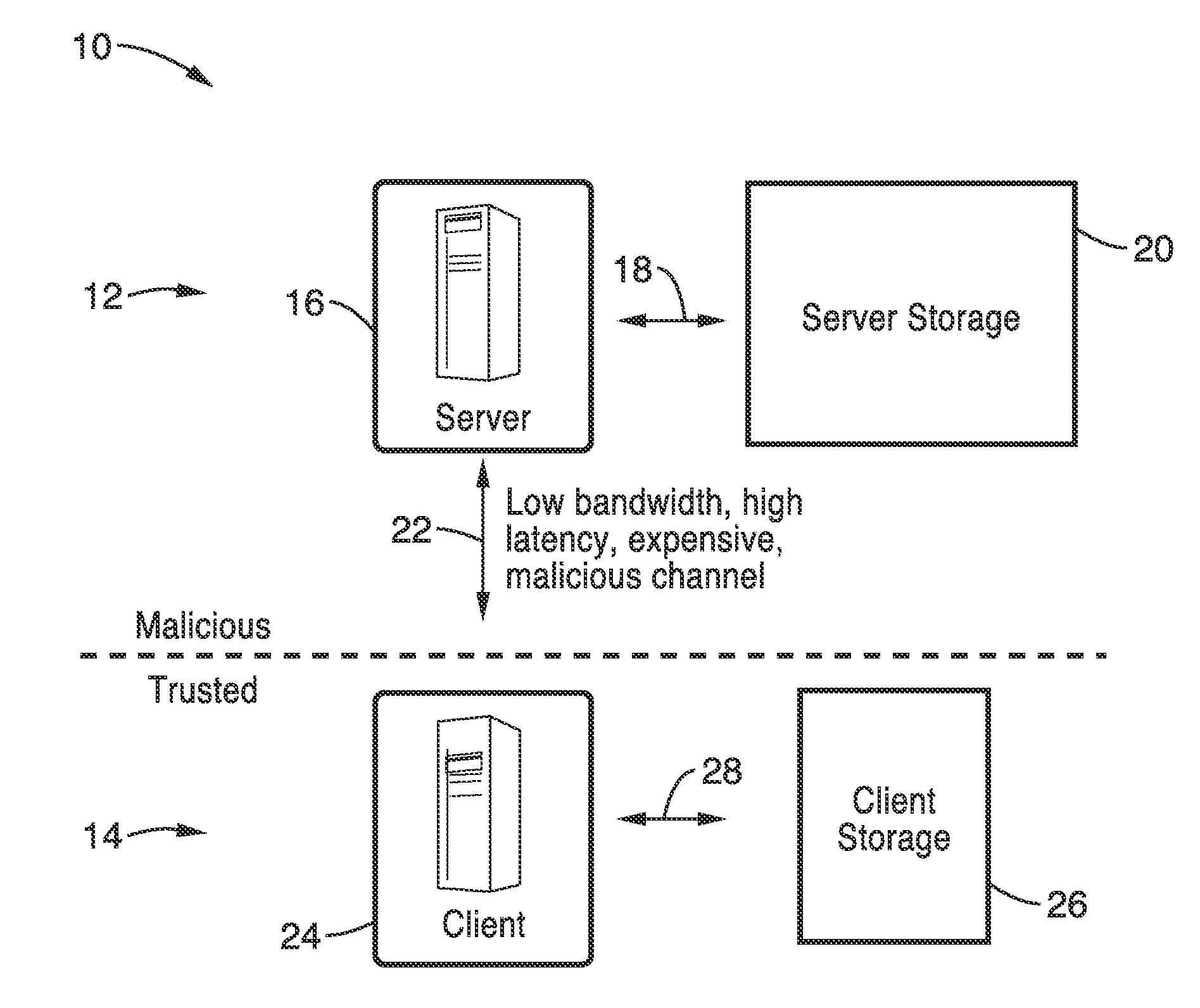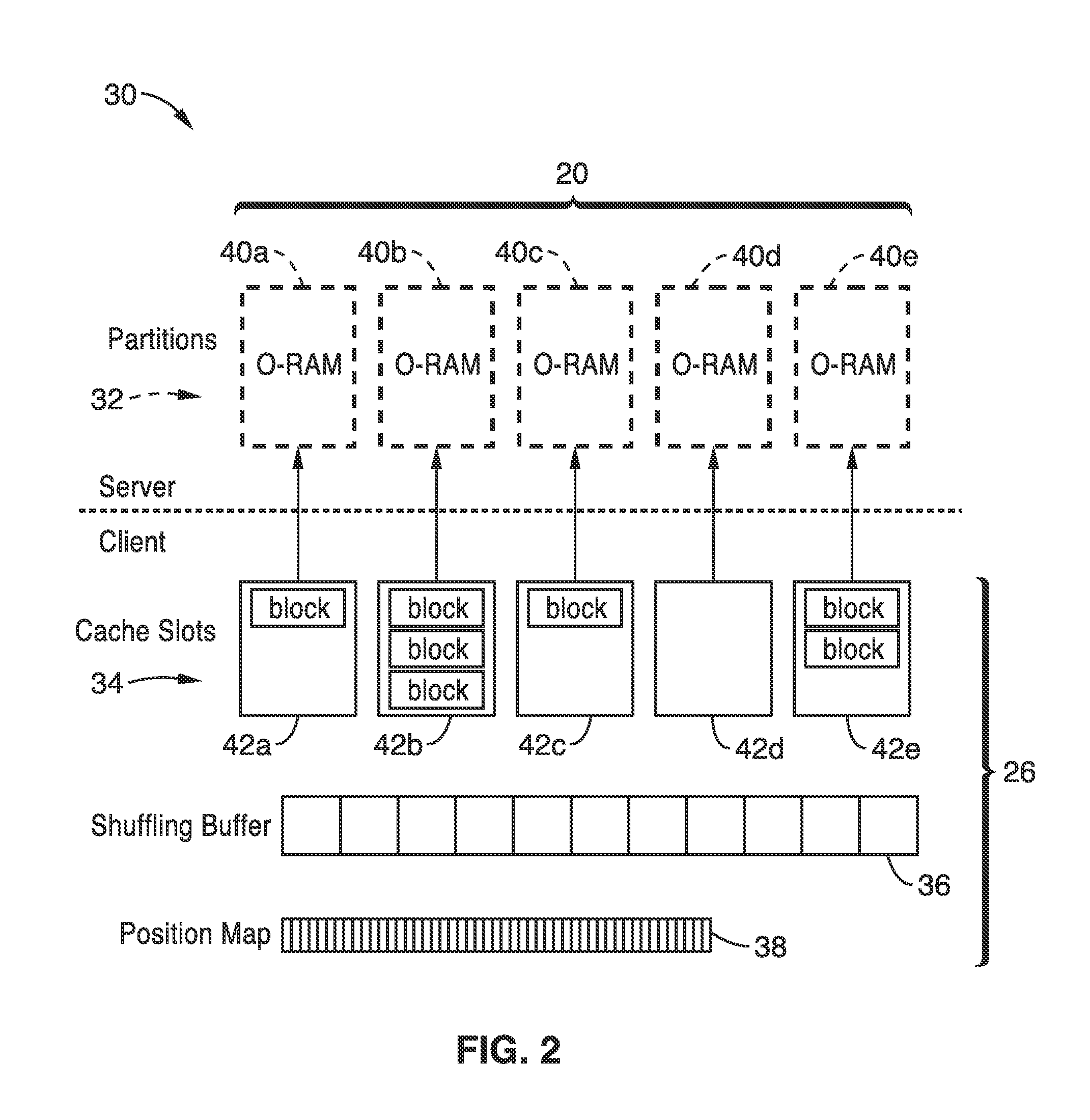Concealing access patterns to electronic data storage for privacy
a technology of electronic data storage and access patterns, applied in the field of computer security, can solve the problems of malicious attackers and others obtaining sensitive information, and achieve the effects of preventing malicious attackers, enabling file encryption, and facilitating access patterns
- Summary
- Abstract
- Description
- Claims
- Application Information
AI Technical Summary
Benefits of technology
Problems solved by technology
Method used
Image
Examples
embodiment 30
[0072]FIG. 2 illustrates an example of a partitioning framework embodiment 30 for the inventive O-RAM system. A server 32 and client side 34 are seen in the figure, as were seen in FIG. 1. On server side 32 partitions 40a through 40e are shown in server storage 20 dividing up the memory that the server uses (e.g., server providing cloud storage services) in fulfilling client requests for storing data. It should be appreciated that in this figure, as well others herein, the number of partitions, slots, blocks, positions in the shuffling buffer and position map are shown by way of simple illustration, however, the practice of the invention is not limited by the number of elements shown by illustration. On client side 34 the figure show a shuffling buffer 36, a position map 38, and a series of cache slots 42a through 42e contained within client storage 26, which was shown in FIG. 1. It will be seen in the figure that cache slots 42a through 42e correspond to partitions 40a through 40e ...
embodiment 190
[0233]FIG. 13 illustrates an example recursive construction embodiment 190. The server side 192 is exemplified with a plurality of O-RAMs (partition groups) 198, 200 and 202 each having inner O-RAMs as partitions. On the client side 194 cache slots are seen associated with each of these O-RAMs within groups 204, 206 and 208. The client side 194 also shows a shared shuffling buffer 196. As seen in the figure, the position map for O-RAM 198 is stored on O-RAM 200, while client position map for O-RAM 200 is stored on O-RAM 202, and so forth. Accordingly, each of the partition groups is just an instance of the O-RAM process of the invention. One should appreciate that the position map of an O-RAM is replaced with another O-RAM and so forth (recursion), while the remainder of the O-RAM method processing remains the same. Captions below each O-RAM indicate the number of partitions the O-RAM has and how many blocks are in each of those partitions.
[0234]Intuition. Instead of storing the lin...
embodiment 210
[0286]FIG. 14 and FIG. 15 illustrate two general O-RAM deployment embodiments. In FIG. 14 a hybrid cloud embodiment 210 of O-RAM deployment is shown. In FIG. 15 there is some trusted hardware in the cloud. This approach appears one promising topology for building future privacy-preserving cloud services. It should be appreciated that FIGS. 14 and 15 are provided by way of example for deploying the inventive O-RAM methods and apparatus, although the inventive elements can be integrated within a wide range of known and proposed topologies, and combinations thereof, without departing from the teachings of the present invention.
[0287]11.1 Hybrid Cloud.
[0288]Referring again to embodiment 210 of FIG. 14 there is an untrusted cloud 212 which is being utilized by a private cloud 214. Within the private cloud are a plurality of clients 216, each client comprising a computer system with secure storage needs. These clients 216 are connected into an oblivious load balancer 218 which directs ope...
PUM
 Login to View More
Login to View More Abstract
Description
Claims
Application Information
 Login to View More
Login to View More - R&D
- Intellectual Property
- Life Sciences
- Materials
- Tech Scout
- Unparalleled Data Quality
- Higher Quality Content
- 60% Fewer Hallucinations
Browse by: Latest US Patents, China's latest patents, Technical Efficacy Thesaurus, Application Domain, Technology Topic, Popular Technical Reports.
© 2025 PatSnap. All rights reserved.Legal|Privacy policy|Modern Slavery Act Transparency Statement|Sitemap|About US| Contact US: help@patsnap.com



